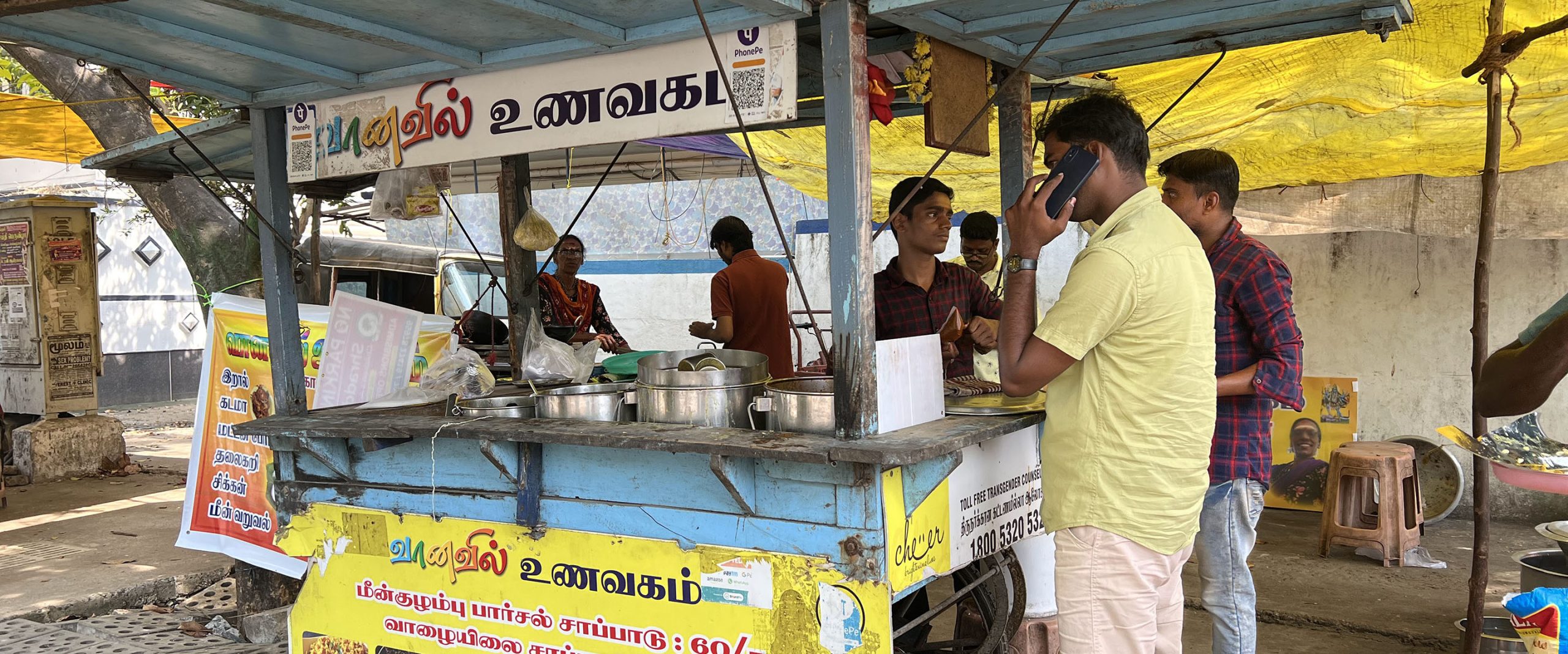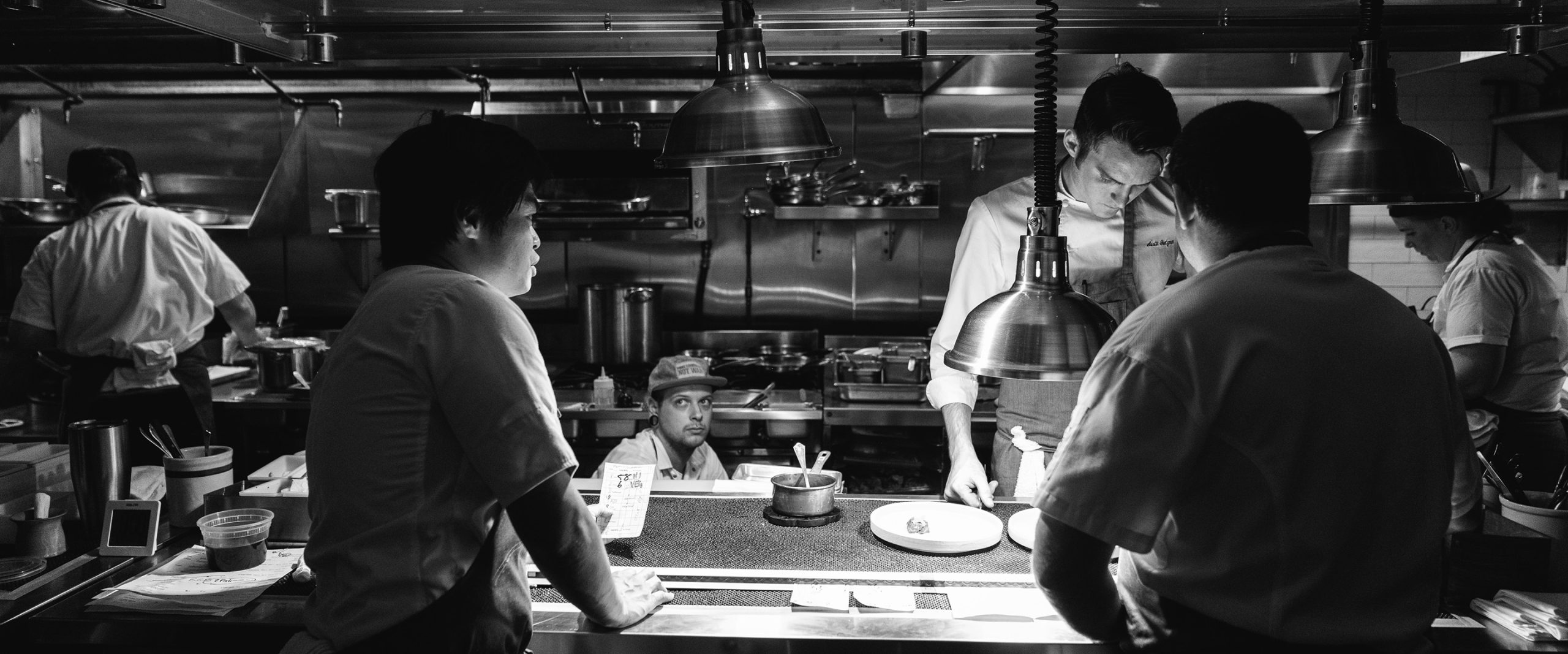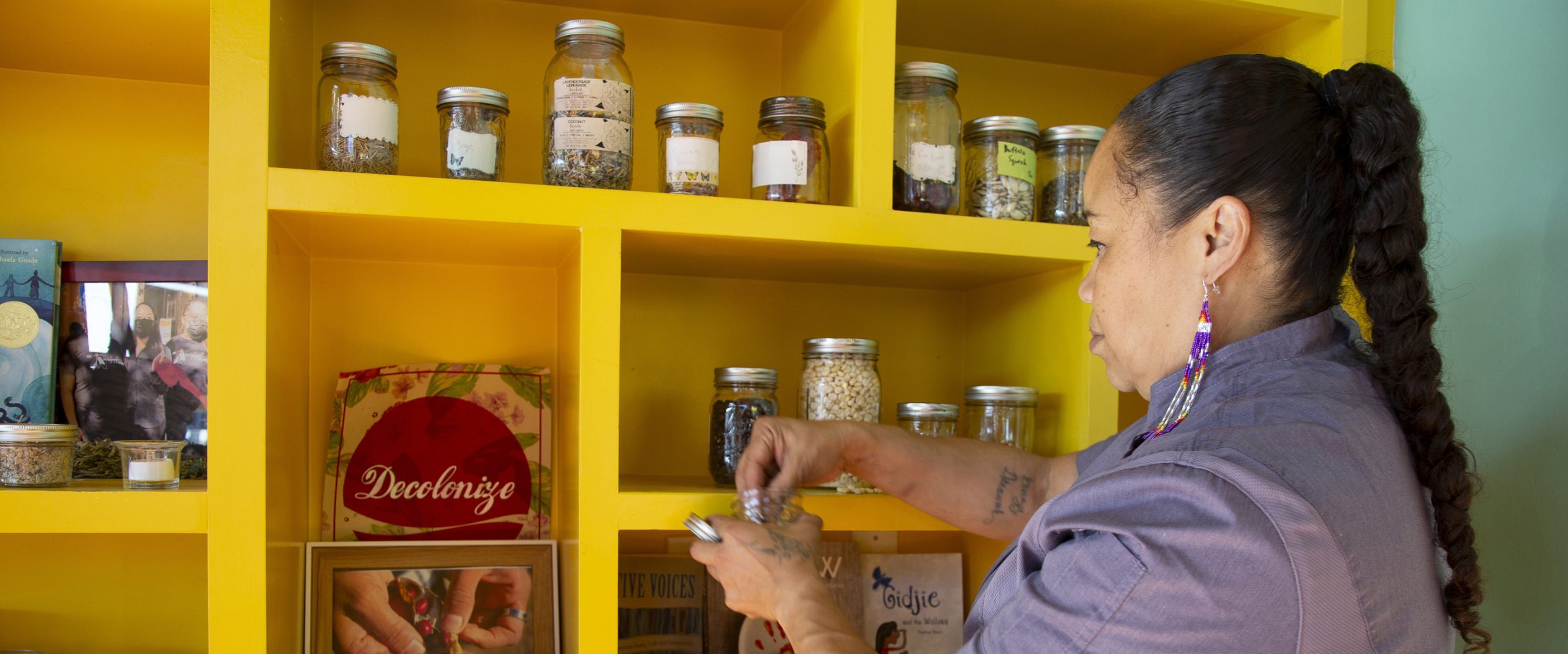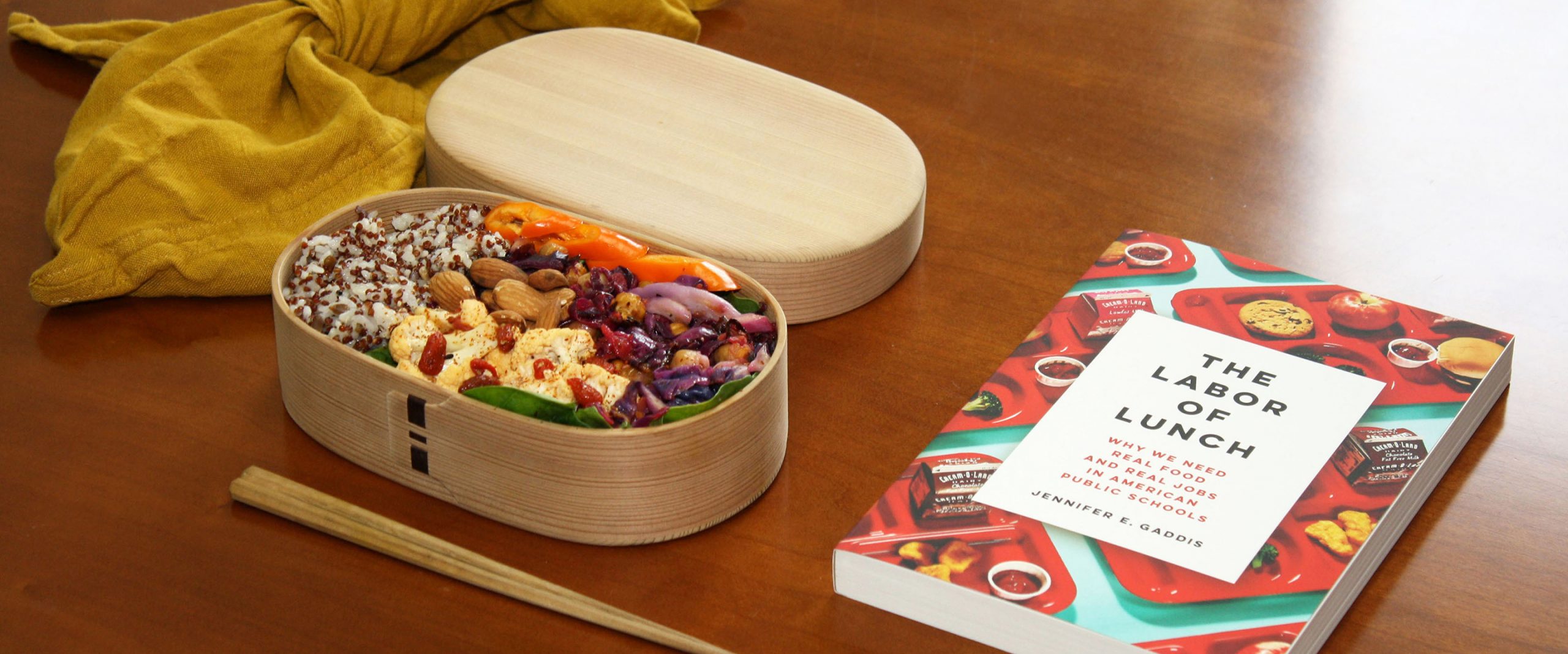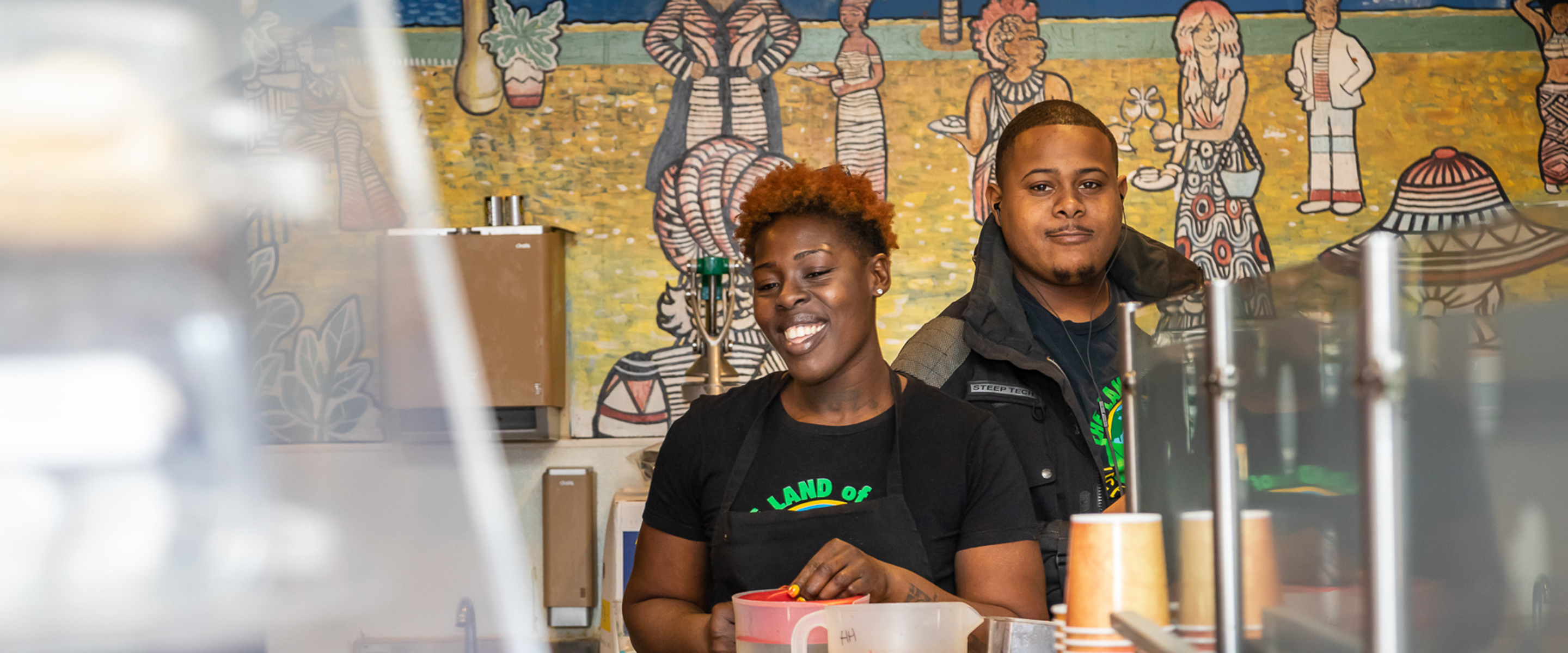The first lesson one learns on the street is that real language needs few words. Transactions take place with minimal communication and the process of food-making is jolted into action with very little ceremony. A cursory glance of acknowledgement, a curt nod, and a show of fingers (two dosa-omelettes, one filter coffee) to indicate one's order, can be the only exchange required to set a well-oiled routine of synchronized techniques in motion.
At Karunanidhi's "window" stall that is situated at the mouth of Kalakshetra Road, in the south Chennai neighborhood of Thiruvanmiyur, two glistening 12-inch cast-iron dosa kals are treated to a rare moment of respite. Real estate - within stalls this size - is always at a premium, leading to Indian street vendors constantly devising ways to work around the space constraint while also adjusting their body techniques accordingly. With the stove placed over a makeshift countertop, and a waist-high ledge in between, Karunanidhi stands on a stool and cooks over the ledge, straining his upper body slightly to lean forward, arms outstretched, to bridge the distance between himself and the two griddles that he mans simultaneously.
Every few minutes, he sprinkles the dosa kal theatrically with a few drops of water to cool it down and the griddle hisses to life, reinvigorated. Regulating the heat of cast iron pans is both an art and a science, often overlooked for being a seemingly pedestrian task in the South Indian kitchen. The mastery over griddle temperature is key to achieving even browning, and perfect rounds that don't stick to the pan, as Karunanidhi churns out up to 200 dosas in a brisk three-hour breakfast service.
The first of two ladles of fermented rice maavu is poured onto the pan from a midair height followed by an assertive thwack against the surface of the kal. This inadvertently performative action both centers Karunanidhi, whose brows are furrowed in concentration, and entertains the growing stream of breakfast regulars on the curb who are allowed to partake in the experience. The scene brings to mind a comment made by American author Michael Pollan in the opening scenes of his documentary Cooked. Pollan observes how "the less time we invest in cooking ourselves, the more time we seem to spend watching other people cook on television, food that we, of course, never get to eat." The veracity of this statement holds true except for one major difference, which is that the premise of street vending in India is built on observation along with instant gratification for both customers - who get to sample the food prepared for their benefit firsthand - and vendors, who are not only remunerated for their efforts but are also usually validated with verbal or non-verbal feedback.
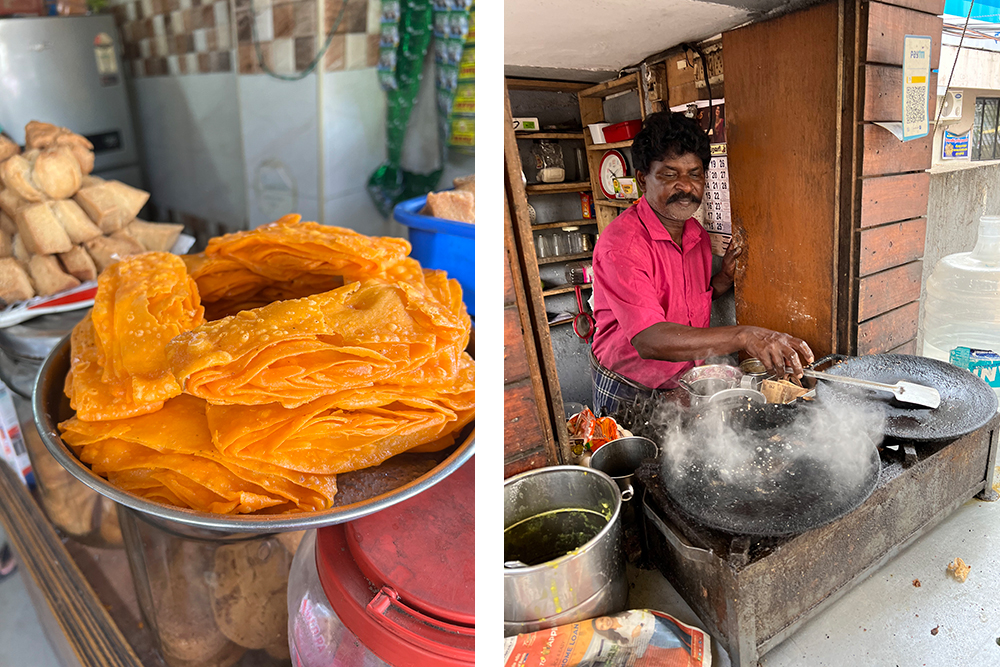
(left) On the street, there is always a moment for a cup of tea or coffee and a sweet treat like the flaky, deep-fried khaja, lightly drenched in a sugar syrup. (right) Street vendors such as Karunanidhi have attained mastery over griddle temperature control, churning out anywhere between 100 and 200 dosas in a brisk three-hour breakfast service window.
In informal cooking settings such as the street, observation and a keen eye for detail step in where a codified template fails to exist, allowing for the reproduction of dishes and techniques. Food scholar and author Fabio Parasecoli puts this into perspective in his paper Savoring Semiotics: Food in Intercultural Communication, pointing out how "even the most perfectly codified recipe, both oral and written, cannot convey in itself the actual experiential and embodied flavors of a dish to somebody who has never tasted it in the first place; moreover certain movements and actions required in its preparation, together with the capacity to know when a dish is ready or at its best, are hard to teach, constituting a bodily experience closely connected with the sensory world of the Cognitive Types."
The hands and body seem, instinctively, to remember what the mind has to work harder for.
Parasecoli's insight takes on new meaning while watching Karunanidhi pour the second spoonful of batter with a slightly exaggerated flourish that allows no time for thought or premeditation. The hands and body seem, instinctively, to remember what the mind has to work harder for. Karunanidhi's cooking style is a language built on a bedrock of dexterity, functionality, matter-of-factness and the reassurance of succumbing to the everyday cadences of his modest al fresco kitchen. It is modeled along an inherited repository of collective embodied knowledge that has been passed on and is, as noted by French sociologist and anthropologist Marcel Mauss in his 1943 essay Techniques of the Body, on display in "the ways in which from society to society men know how to use their bodies."
The backside of the rounded ladle is used to swirl rounds in an increasing circumference from the center of the pan to its outer surface. Two seconds later, as bubbles perforate the dosa, the sides are slicked down with oil to ease the seemingly effortless flip that is to follow, after which the dosa will be folded into a perfect crescent and served from stove to plate.
Young IT professionals stand facing the stove, with backpacks strapped jauntily to their shoulders, as they balance melamine plates at chest level with one hand, while using their dominant hand to funnel food into their mouths. Karunanidhi routinely turns his attention from the dosa griddles to his customers and shouts out, "Dosa, sapidareengala?" encouraging them to eat a second or third hot dosa.
Watching Karunanidhi at work is a living testimonial to a core ideology preached by renowned American chef Thomas Keller.
Despite the unwavering gaze of his audience, Karunanidhi cooks without inhibition. His style is deeply rooted in repetitive actions and techniques, and combined with the breakneck speed at which dosas fly off the kal, very little can make him lose his rhythm. Watching Karunanidhi at work is a living testimonial to a core ideology preached by renowned American chef Thomas Keller. In an interview with the Los Angeles Times, he says, "Something has to catch your eye and make you want to cook it. And then do it over and over again. It's all about repetition. If you're successful the first time you do it, it's probably just luck. Find something that resonates with you."
His movements are so quick they're often hard to capture on camera and the only time he allows himself a break is to dart out from behind the stove to the street and pack takeaway orders. Observed carefully, one will notice that even when he tears himself away from cooking duties, he sways gently, shifting his body weight from one side to the other - while sloshing homogenous brown curries into plastic bags that he twists and secures with twine - almost as though afraid that if he stops rocking, for even a minute, a magical balance will be lost, never to be restored.
The volley of orders is relentless and customer's real-time requests punctuate the air at these stalls. "Omelette nalle pannange, anna," requests a diner as he pauses thoughtfully between bites, galvanizing Karunanidhi into an egg-whisking frenzy. A modest steel mug serves as an alternative to an electric egg-beater and mixing bowl, which Karunanidhi holds at a slight angle to his side and beats aggressively into submission with a spoon. The loud clanging noise is deafening and his techniques, while efficient, lack finesse. The egg mixture is poured directly over a half-done dosa and he uses a vigorous forearm and wrist-reliant scrambling motion with his stainless steel spatula to ensure equal surface area coverage. A pinch of pepper is sprinkled directly from a 100gm Aachi sachet with little fanfare.
If Mauss draws intention to the physiological aspects of deeply-embedded bodily techniques, Associate Professor of Philosophy Robert T. Valgenti emphasizes the personal and interpretative nature of cooking, which sees people making these skills their own, in his paper Cooking as Interpretation. The art of cooking, according to Valgenti, "is always performed within a horizon or context and is never merely the application of a set of techniques." He references French chef Thierry Marx's response when asked about terroir and its effect on a particular breed of lamb he had prepared. Marx went on to respond that ultimately, terroir was not about geography or a place, but is, in fact, inside of him.
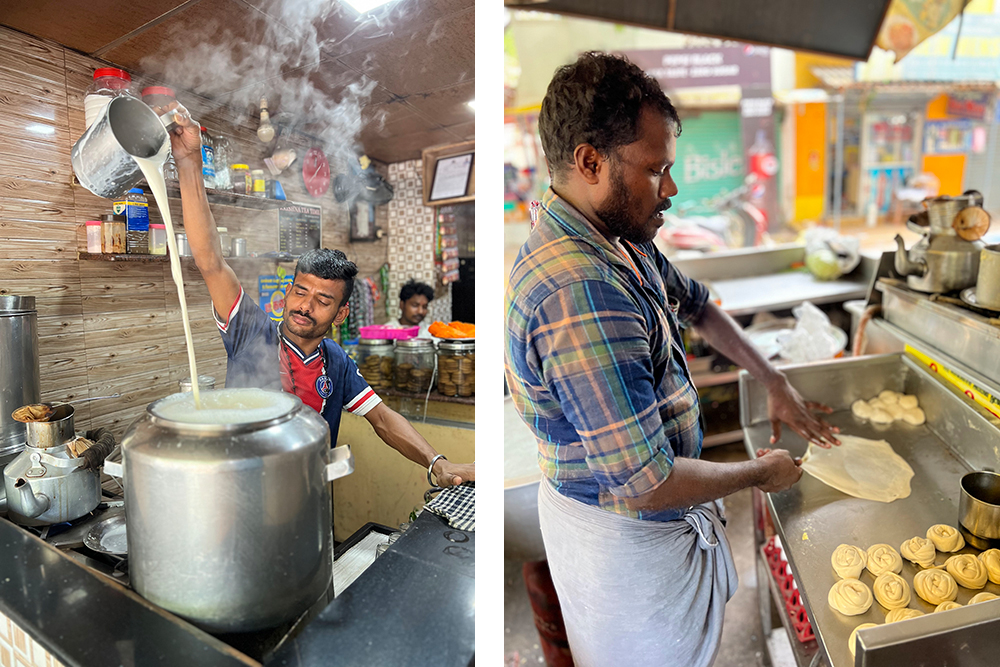
(left) A migrant tea-stall worker from north India lends a touch of everyday theatrics to the act of serving tea with flair. (right) Porotta "master" Velasamy works at a stall in Indira Nagar, where he is accorded the title of respect informally conferred upon vendors on the street who execute everyday food artistry with nonchalance. He makes light work of a technique that merits its own space in the world's finest pastry kitchens.
This idea of a personal, existential terroir is furthered by writer Charlotte Druckman in an article for Gastronomica: The Journal of Food and Culture, titled A New Reign of Terroir. Druckman puts it down to each chef having "an inimitable culinary fingerprint, that the food he or she makes is an index tracing the past" - a thought on exhibit at stalls such as Karunanidhi's where the momentum, pace and distinctive stamp of dosa-making are underpinned by his unique style. While his wife Dhanalakshmi is the co-pilot of their operation, he is seen as the face of their breakfast service and this becomes clear when she takes over cooking duties for a half hour. There is a noticeable lull in both business and the general energy, and a couple of customers ask, "Anna illaya?", politely enquiring after her husband's whereabouts, displaying a loosely-concealed preference for Karunanidhi's dosas.
The differences in their work, and how it is received, exemplify the gendered nature of food-making and its clear-cut division of labor and roles
Unlike her husband, who exhibits an almost factory-line speed, precision and dexterity when it comes to execution, Dhanalakshmi's dosa-swirling skills are gentle and unhurried. The differences in their work, and how it is received, exemplify the gendered nature of food-making and its clear-cut division of labor and roles - men are most often seen flipping dosas and making porottas while women display a natural proclivity towards the preparation of the more elaborate lunchtime meal.
Krishnendu Ray, author and Director of New York University's Food Studies PhD program, draws from his own anecdotal observations while traveling across Zanzibar and Tanzania to point out how factors such as locational differences, the time of day and the associations ascribed to various foods can have a bearing on the gendered terrain of street cooking. He uses the example of the regional chapatis or parathas (fat-added breads) and the fried or shallow-fried stuffed parathas, referred to as Zanzibari pizza to make his point. "They taste different, they look different and they're cooked by different genders." Of most interest, is the fact that "the so-called chapatis (parathas in some ways) are all done by women in the marketplace (sitting down and largely sold early in the morning for a working-class breakfast), and are mostly a breakfast food. Zanzibari pizza, on the other hand, is a late-afternoon or late-evening or late-night snack, cooked by men standing up and stuffed (a bit like the Bengali Mughlai paratha that has eggs in it, it might have some meat and it has flour)."
The similar but different foods are classified, respectively, as a "domain of necessity" and a "domain of luxury" by the same category of working-class people who consume them.
The similar but different foods are classified, respectively, as a "domain of necessity" and a "domain of luxury" by the same category of working-class people who consume them. "The so-called Zanzibari pizza is often made at fairs and late at night. People cook and eat it to have fun. This is very different from people eating the Zanzibari chapati before they go to work in the morning. There is a functionality to it. Cooking in the morning is all done by women sitting down. In the evening, it is done by men with flair and it is like a special food." What merits further study and observation is how the body techniques enlisted in the making of various foods are related and change according to gender.
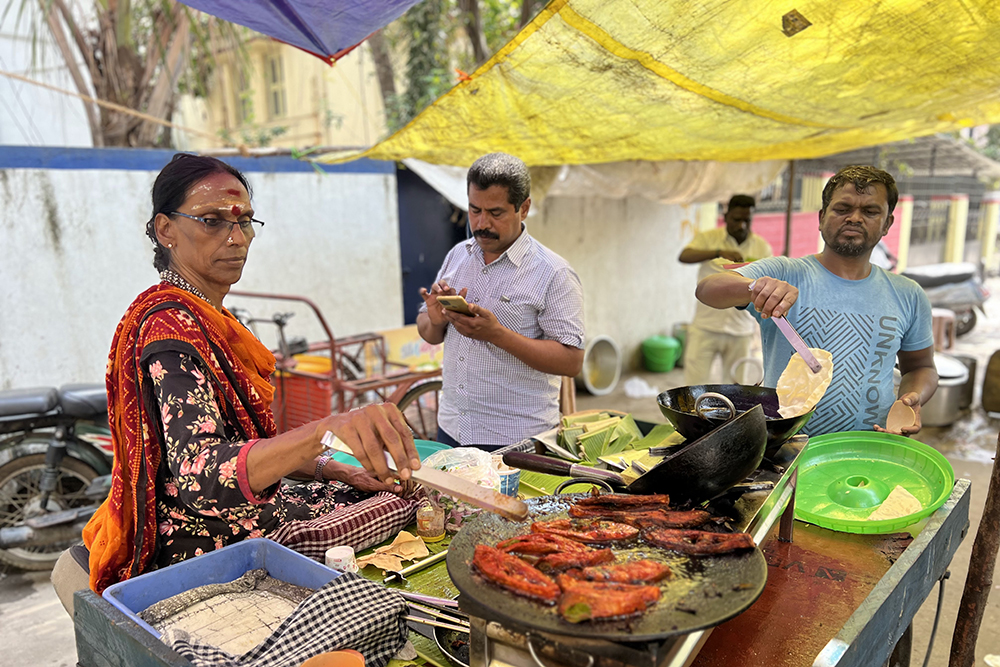
Aruna Rani (left) runs a pushcart lunch stall in the south Chennai neighborhood of Indira Nagar, where she sears industrial-sized batches of fish that have been marinated in a secret home blend. Her cooking style is distinct in that she prefers to tend to the stove while seated, with an arm delicately outstretched, adopting an almost regal stance.
Porotta "master" Velasamy, who works at a stall in Indira Nagar, is accorded the rare and well-deserved title of respect informally conferred upon vendors on the street who execute food artistry with everyday nonchalance.
He switches seamlessly from the rigorous, theatrical push-and-pull motion demanded while kneading dough - left foot positioned a few steps ahead of the right, and at a slight angle, drawing from endless reserves of upper body and forearm strength, to propel himself forward while working the dough. The palms of his hands take it in turns to flatten and stretch two sections of the pliable mass simultaneously - enlisting the strength of first the left side of his body and then shifting energies to the right.
Once the dough has achieved a desirable texture and is deemed ready, it is sectioned into equal tennis ball-sized portions, flattened with one palm against the stainless steel countertop and slathered generously with a fat of choice. It is then slapped against the countertop about ten times and thrown into the air at a slight angle, landing on the surface with an assertive lurch, after having taken a little somersault. With each throw, the dough gets thinner and more pliable - the result of a seasoned wrist technique that would be hard to articulate in the most detailed cookbook, even if accompanied by illustrations. As a finishing touch, it is coiled into a tight cinnamon-bun shaped knot.
Velasamy makes light work of a technique that merits its own space in the world's finest pastry kitchens, finishing each porotta within a span of about 40 seconds, displaying mastery over a process he claims to have picked up by pure observation, at a hotel kitchen in the town of Nagapattinam, at the age of 13. Watching Velasamy in action reiterates the significance of embodied ethnography - defined by Dr Nuno F. Ribeiro as "the use of the body as an actual research tool, that is, one's own body becomes the/one of the medium(s) through which experiences are lived, catalogued, and analyzed" - as a qualitative tool of research and enquiry while documenting food-making techniques.
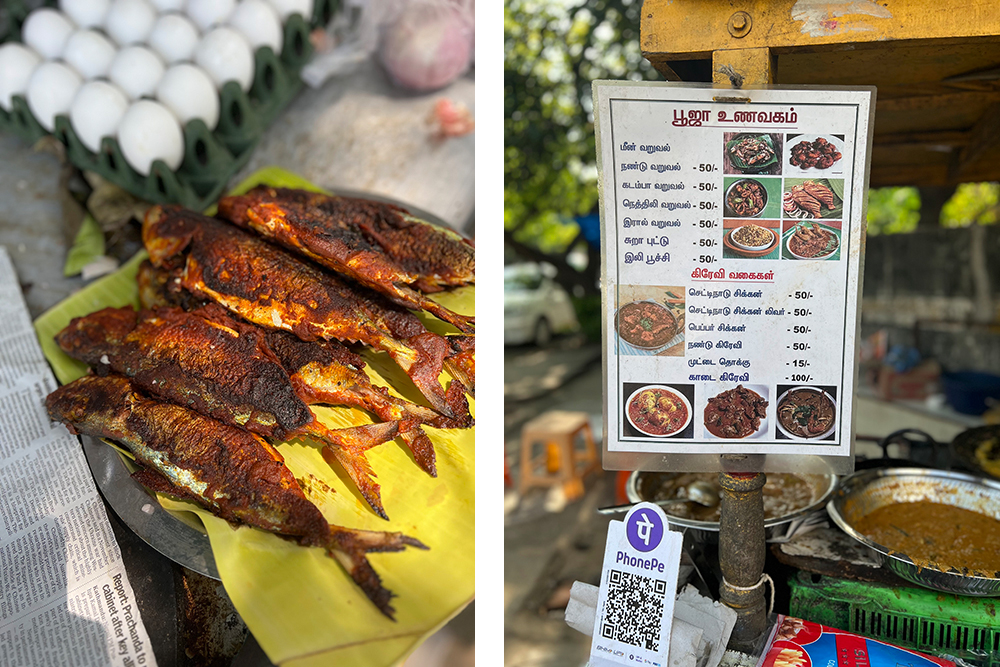
(left) Chennai's coastal location ensures that seafood remains an integral component of the lunchtime meal with smaller varieties of fish serving as an economical option to daily wage workers. Pictured here marinated in a red chilli powder, turmeric, and ginger and garlic paste. (right) A pushcart stall advertises its lunchtime seafood offering, including fried variations of prawn, squid and fish, as well as home-style seafood curries that are locally referred to as kozhambus.
Elana Michelson opens up the discourse around how the body can be explored as a site of learning and resistance by analyzing how "bodily experiences can serve as the basis for knowledge creation", in her 2015 work Gender, Experience, and Knowledge in Adult Learning: Alisoun's Daughters. She goes on to reference Sandra Harding's Whose Science? Whose Knowledge? Thinking From Women's Lives to drive home the importance of knowledge born of experience drawn from people in oppressed social categories as "agents of knowledge, as actors on the stage of history, as humans whose lives provide a grounding for knowledge claims that are different from, and in some respects preferable to, knowledge claims grounded in the lives of men in the dominant groups".
On Sundays and Wednesdays at the Thiruvanmiyur Fish Market, women make the act of fish cutting a language of their own. Two open-air spaces dedicated to the cleaning and cutting of fish are located within 100 metres of each other and each is patronized by a loyal clientele. While the older marketplace is spread across an empty rubble-filled dirt ground, with fish being displayed out in the open and in styrofoam boxes and crates, the newer entrant maintains some semblance of organization and hygiene as fish can be procured within a covered hall and brought outside to be cut by groups of women who sit sentry on the steps.
Their hands do as much work as the eyes
At both spots, women adorned in boldly printed saris and defiantly contrasting blouses, assume distinct "sitting" poses over the traditional aruva manai, with their pallus draped functionally over one arm and secured around the waist. Some sit upright while others lean forward, hunched over this floor-level cutting instrument as their hands work the fish, rocking to keep a rhythm - known only to their bodies - going. Their hands do as much work as the eyes and they alternate between looking intently at the blade while filleting fish to sneaking quick sideways glances into the distance while feeling the innards instinctively with their fingers, pulling out gunk and gutting it.
Handling big and smaller fish enlist slightly different techniques with the risk of being cut posing more of a hazard with the latter category. The women commence work by dipping their fingers in a grainy mixture of sand to assist their grip. The fish is initially held horizontally, to nip off the fins and tails with a clean straight cut on the blade. The position then shifts to a slant and the fish is scraped, to a grating rhythm, against the blade to remove the scales.
While the women at the newer market sit in a row, on a low floor step that offers a slight elevation, a few women at the open-air market have allowed themselves some concession in the way of comfort using a degree of innovation to raise their bodies from ground level. They sit regally, astride the aruva manai - which has been centrally positioned in the manner of a bridge between two crates - that is held down by the weight of its user on one end. One leg remains stationed on the ground while the other is drawn up to the thigh (across the base plank) in an effortless 90-degree, "L" shape. Still others of the "crate brigade", have conceived their own unique postures - such as positioning the aruva manai at a slight slant at the edge of one crate and sitting sideways with one foot firmly planted on the ground and the knee of the other leg weighing down the base with the same foot dangling above the ground - to support the needs of their bodies and provide short-lived relief to the aches and pains that they uniformly complain of.
Usually featuring a curved blade rising out of a narrow plank of wood that serves as its base, the aruva manai or arivalmanai, as it known in Tamil, is used in various other parts of India and goes by several regional names such as the kathipeeta in Telegu, vili in Marathi and panikhi in Odia. It presents itself in slightly different manifestations of blade and base, depending on the uses (ranging from fish gutting and cutting to coconut scraping and vegetable cutting) for which it is enlisted. At the Thiruvanmiyur markets, the blade of the aruva manai resembles a straight five-inch serrated knife. It stands upright like a rigid ruler with its jagged teeth facing away from the women. The women who opt for the most conventionally observed technique are seen - as observed by Chitrita Banerji in her article The Bengali Bonti for Gastronomica - to "either squat on one's haunches or sit on the floor with one knee raised while the corresponding foot presses down on the base". Banerji likens this technique - and the squatting or sitting on the floor for "indefinite periods of time" that it warrants - to those exhibited in other "floor-oriented" cultures such as Japan.
The evolution from squatting to sitting to eventually standing and the changing body movements that accompanied these shifts "around the Indian Ocean world" is something that Ray points out is often "under theorized, under investigated and under reported"
The evolution from squatting to sitting to eventually standing and the changing body movements that accompanied these shifts "around the Indian Ocean world" is something that Ray points out is often "under theorized, under investigated and under reported" because of the "naturalized developmentalist presumption that modernity obviously means standing up and sitting down and the cutting, washing, cooking and body movements that go along with that." This realization took on new meaning for him when considering that generationally, within his own family, both grandmothers who were from a small town "were clearly part of a squatting civilization, and this was linked to architecture - meaning the level at which water came in was at about three feet from the floor."
The other aspect was that "all dish-washing, cutting, techniques and technology like the bonti and the wooden chulha (traditional stove) were performed at ground level". According to Ray, the shift in bodily postures adapted in the kitchen probably began to be noticeable when women of a certain generation and class - which he terms a "transitional class who were moving from the working class to the lower middle class" - responded when confronted with change while moving to larger cities. The innate ease with which most of these women had spent a significant part of their lives squatting while undertaking activities such as cooking and cutting, meant that it was something they took with them and continued to favor. This becomes apparent when Ray adds that, "When we moved to Kolkata, my mother was still squatting. Even now, she is most comfortable squatting."
Ray attributes his own limited exposure to the body movement, "which is heavily gendered", to the fact that while he would never do the cooking in India, he and his brother were expected to wash their own clothes squatting, while growing up. What needs to be acknowledged when evaluating embodied techniques, according to Ray, is that "there is a relationship between gender, generation, architecture and city and that's the fascinating work that can be done, which is made invisible with the presumptions that are ubiquitous - at least in the western world."
If the modern-day western predisposition to cooking while standing demands an increased dependence on hand muscles, then squatting draws from lower body strength and a reliance on the use of the leg and thigh muscles, which is being adopted less and less. In Techniques of the Body, Mauss reminds us that "The child normally squats. We no longer know how to. I believe that this is an absurdity and inferiority of our races, civilizations, societies." He goes so far as to say that "It is a very stupid mistake" to take squatting away from a child and attributes the changing importance of this posture "in the series of ages of the human race" to the fact that "curvature of the lower limbs was once regarded as a sign of degeneration". A physiological explanation has since been given for this racial characteristic, which "is now called Neanderthal man" who had curved legs that were a result of having normally lived in a squatting position.
More importantly, Mauss brings attention to the fact that "A certain form of the tendons and even of the bones is simply the result of certain forms of posture and repose" and it is, therefore, "possible not only to classify techniques, but also to classify their variations by age and sex." This notion is on no better display than in Chennai, where if fish cutting at markets is largely seen as being a woman's domain, then butcher shops are viewed as a men's terrain. While women appear to be more used to engaging their lower body strength while squatting and sitting, men can be seen summoning reserves of upper body energy while standing for prolonged periods.
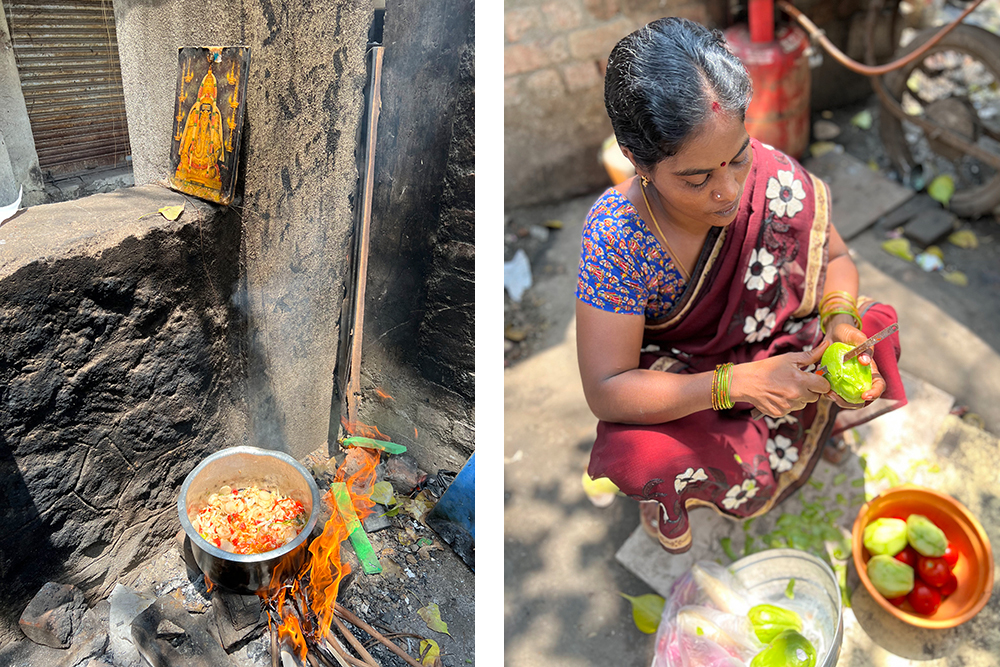
(left) The woodfire-stoked virugu aduppu is integral to husband-and-wife duo Kandan and Usha's lunchtime operation, which comes to life, every afternoon, from a discreet makeshift cooking arrangement. (right) Usha peels the skin of chayote or chow chow, as it is referred to regionally, with a flimsy knife that can only be likened to a 30-centimeter ruler attached to a plastic handle. She metes out an impressive range of treatments to the bucket of vegetables at her feet, achieving different cuts and textures with this modest tool.
At D. Muneer Ali's meat shop in Indira Nagar, there is nothing impersonal about the act of choosing a cut of meat and it would seem as though his inimitable knife skills have been sharpened to cater to regional preferences. Clad in a white ribbed shirt, jeans, belt and a crocheted Muslim prayer cap, he bears an unassuming air of distinction while speaking to customers through a glass window. Goat carcasses dangle from ceiling hooks with the tails often swishing in customer's faces as they put in their orders for "biryani cut" (larger bone-in pieces used for dishes such as biryani where meat is the centerpiece); "curry cut" (smaller bone-in pieces used in curries and kozhambus), "paaya" (trotters that often go into a thick savory broth); and "keema".
Equipped with a modest rectangular-bladed tool that resembles a hatchet, they sever dense cartilage, bones and meat; saw through ribs; hack trotters and shave them with the delicacy usually reserved to peel soft fruit; and attain a mince consistency that is so fine it would put any industrial meat grinder to shame.
The wood is sourced from the forests of Maharashtra and Andhra Pradesh and does not splinter easily
Ali treats his meat and customers with equal reverence, and there is a sense of ceremony that prevails while watching him get behind the counter and get ready for the day's proceedings. He steps on to a stone slab that offers him an elevation and places the customer's desired cut on to a cylindrical log of wood that stands at a height of about three feet and comes up to his waist. Referred to locally as the thirinni ka kunda, this log is the preferred choice of butcher's block according to Ali. The wood is sourced from the forests of Maharashtra and Andhra Pradesh and does not splinter easily, which is vital because of the strong degree of pressure from the knife it is subjected to on a daily basis. The cleaning process is equally elaborate and at the end of every day, Ali demonstrates a knife scraping technique that is applied against the grain of the log, to clean the wood and strip it of any remnant meat particles.
The two most noteworthy techniques that Ali displays are also the hardest to document. When unaware of being watched, he positions his body at a slant from the thirinni ka kunda while cutting trotters. His index and middle finger automatically assume a natural "V" formation between the bolster and heel of his knife yet freeze self-consciously when asked to demonstrate for the camera. A similar position is employed by the dominant knife-cutting hand while mincing meat, with the only difference being that the palm of the left hand clasps the right hand (with the left thumb placed over the right thumb), to provide that much-needed grip for the half-second intervals at which the knife lands on the block with a rhythmic pounding sound. The fatty boneless mound of meat is worked methodically in a row-by-row motion, from left-to-right and then in the reverse direction, until it is deemed ready.
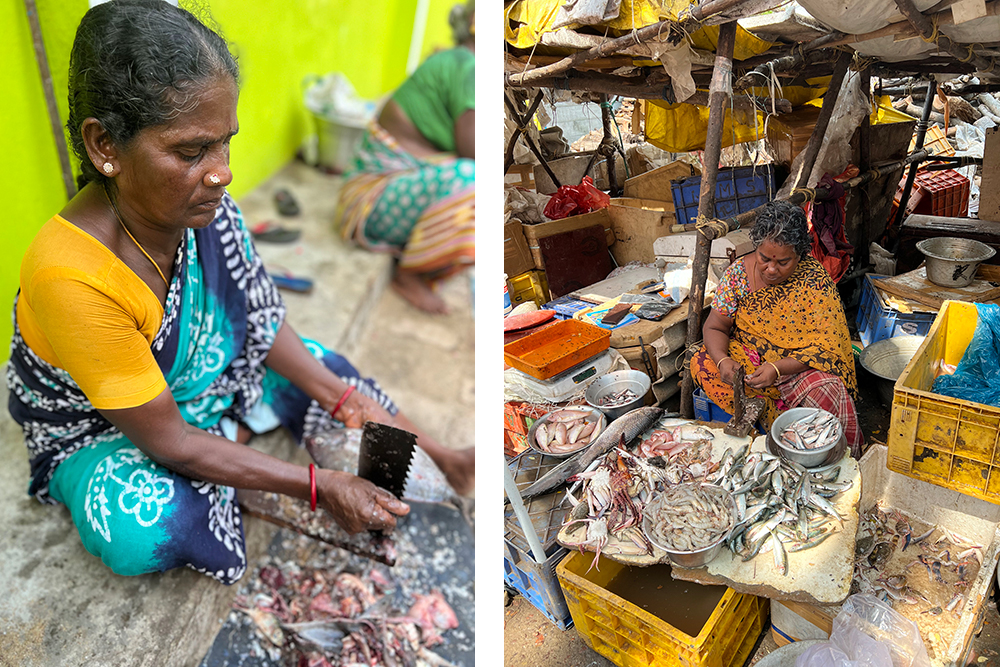
(left) On Sundays and Wednesdays at the Thiruvanmiyur Fish Market, women make the act of fish cutting a language of their own, assuming distinct sitting poses over the traditional floor-level cutting instrument known as the aruva manai. (right) When it comes to fish cutting, the hands seem to do as much work as the eyes. Some women sit upright while others lean forward, hunched over as they alternate between looking intently at the blade to sneaking quick sideways glances into the distance.
The fluidity with which women have learned to adapt their bodies - as a result of their circumstances; shifts in geography; and physical settings - is on display watching pushcart vendor Usha, who literally makes the street her kitchen. She puts together an elaborate lunch featuring rice and all the requisite accouterments that one would find being produced, seemingly effortlessly, out of home kitchens across the state of Tamil Nadu come noon. The sole point of difference is that Usha and her husband Kandan have set up a discreet makeshift cooking operation behind their pushcart on Kalakshetra Road. They also stand out in that, even on the street, other lunchtime pushcart vendors choose to cook meals out of their own home kitchens or small rented spaces and then transfer everything into steel buckets on site. Rice and fried fish are usually the only components of the meal that are cooked on the spot.
The tenets governing the lunchtime meal are not rigid but there is a loose framework that binds it: boiled rice serves as the carbohydrate component; there is likely to be a lentil-forward sambar or kootu that features legumes prepared with vegetables; a poriyal that sees vegetables being lightly stir-fried and tempered with lentils and spices; a cooling buttermilk drink or spiced hot rasam; and crunchy textural relief in the way of deep-fried appalams. Fish can make an appearance in the way of a meen kozhambu gravy or is marinated and fried. The result is what would, to an outsider, rightly appear as nothing short of a feast that is replicated day in and day out with varying ingredients that are often a nod to seasonality. Of most interest, is the fact that even on the street, customers have come to not only expect the same levels of intricacy that they would at home but are also able to enjoy it for about Rs50 (under US$1) with fried fish being a Rs10 add-on.
Without the luxury of an expansive cooking space; multiple vessels; a designated washing and preparation area; and not so much as a chopping board to assist the process, Usha must rely on a strong degree of ingenuity but mostly the adeptness of her own body to put together a full-fledged meal in just two hours. Organizational skills are key, as is efficient stove management, and so the cooking process begins by ensuring every ingredient is prepared and chopped, ready to be tossed into her assorted preparations. The first consideration that silently governs cooking in a setup like this is that there is no running water, which would, in itself, seem like an inconceivable setback when producing lunch on the scale that the couple does. Potable water is stored in plastic drums and has to be used resourcefully for not only rinsing vegetables (which are all submerged in a bucket and given a single soak and rinse) but also to cook and wash dishes between customers.
She works efficiently as the world outside passes by, punctuated by the aggressive sounds of blaring horns and mid-morning traffic.
Although in no way a covert operation, the average passer-by would be oblivious to the fact that Usha cooks right under their eyes because she sits behind the cart, on a single concrete slab that serves as a tiny stool. She maintains a three-foot distance between her knees as she crouches down, while cutting, so that her chin is almost cupped by one knee. Assisted by what can only be likened to a flimsy 30-centimeter ruler attached to a plastic handle, she metes out different treatments to the bucket of vegetables at her feet, achieving different cuts and textures with a single knife. Moolangi (daikon radish) is cut into even, wafer-thin rounds with a precision that would make one question the purpose of a mandolin. The skin of chayote or chow chow, as it is referred to regionally, is peeled by cupping the vegetable in the palm of one hand - with the thumb and index finger providing a grip - while the thumb of the working hand moves along with the index finger that guides the cutting while being safely tucked inwards. It is then cut longitudinally and held together while being diced against the non-dominant thumb and index finger in what would be considered to pose a serious safety hazard in a professional kitchen. In the absence of a sieve, her hands are used to strain a tamarind mixture and also to crush tomatoes into a rustic pulp for the rasam. She works efficiently as the world outside passes by, punctuated by the aggressive sounds of blaring horns and mid-morning traffic. To observe Usha is like being granted entry into the silent inner workings of her mind and body.
The cooking in itself demands a contradictory blend of very little hands-on tending to - with base ingredients being given an initial sauté and then left alone to come together almost magically - and great reserves of physical energy. What merits most attention is Usha's cooking style, which is a constant juggling act between shifting energies from cooking at the two-burner stove at the pushcart and the wood-fire stoked viragu aduppu behind her, while handling the shifts from standing to sitting and bending that this entails. There is a natural fluidity to her movements - sitting to cut; squatting to rinse the dishes; bending to stoke the hungry fire and fan its flames in the unforgiving Chennai heat; standing while preparing the chow chow poriyal and moolangi sambar, which when half-done will be finished off on the adippe; and bending with one hand folded behind her back as she sweeps with a broom made of dried coconut leaf stalks. She has conceived a lexicon that is all her own.
Jehan Nizar is an independent features writer and food researcher based in Chennai, India. Her work most often explores food as a point of convergence for history and anthropology, and she has a special interest in documenting the foodways of peninsular India. Jehan has contributed to national and international publications such as PEN America, Whetstone Magazine, The Spruce Eats, Gulf News, The Wire, The Wire Science, Firstpost and Verve Magazine. She formerly wrote food columns for Asiaville and News9. When she's not writing, she is passionate about sharing her love for words with students at The Asian College of Journalism in Chennai, where she is a core member of faculty and teaches a course in feature writing.









